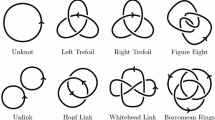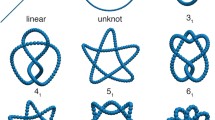Abstract
In a thermally fluctuating long linear polymeric chain in a solution, the ends, from time to time, approach each other. At such an instance, the chain can be regarded as closed and thus will form a knot or rather a virtual knot. Several earlier studies of random knotting demonstrated that simpler knots show a higher occurrence for shorter random walks than do more complex knots. However, up to now there have been no rules that could be used to predict the optimal length of a random walk, i.e. the length for which a given knot reaches its highest occurrence. Using numerical simulations, we show here that a power law accurately describes the relation between the optimal lengths of random walks leading to the formation of different knots and the previously characterized lengths of ideal knots of a corresponding type.
Similar content being viewed by others
References
Sumners, D. W. and Whittington, S. G.: Knots in self avoiding walks, J. Phys. A: Math. Gen. 21 (1988), 1689–1694.
Matthews, R.: Knotted rope: a topological example of Murphy's law, Math. Today 33 (1997), 82–84.
Frank-Kamenetskii, M. D., Lukashin, A. V. and Vologodskii, A. V.: Statistical mechanics and topology of polymer chains, Nature 258 (1975), 398–402.
Rybenkov, V. V., Cozzarelli, N. R. and Vologodskii, A. V.: The probability of DNA knotting and the effective diameter of the DNA double helix, Proc. Nat. Acad. Sci. U.S.A. 90 (1993), 5307–5311.
Deguchi, T. and Tsurusaki, K.: A statistical study of random knotting using the Vassiliev invariants, J. Knot Theory Ramifications 3 (1994), 321–353.
Janse van Rensburg, E. J., Orlandini, E. Sumners, D. W., Tesi, M. C. and Whittington, S. G.: J. Knot Theory Ramifications 6 (1997), 31–44.
Koniaris, K. and Muthukumar, M.: Knottedness in ring polymers, Phys. Rev. Lett. 66 (1991), 2211–2214.
de Gennes, P. G.: Scaling Concepts in Polymer Physics, Cornell Univ. Press, Ithaca, 1979.
Alper, J. and Nelson, G. L.: Polymeric Materials: Chemistry for the Future, Amer. Chem. Soc., Washington, DC, 1989.
Orlandini, E., Janse van Rensburg, E. J., Tesi, M. C. and Whittington, S. G.: Entropic exponents of knotted lattice polygons, In: S. G. Whittington and D. W. Sumners (eds). Topology and Geometry in Polymer Science, Springer, New York, 1998, pp. 9–21.
Katritch, V., Bednar, J., Michoud, D., Scharein, R. G., Dubochet, J. and Stasiak, A.: Geometry and physics of knots, Nature (London) 384 (1996), 142–145.
Stasiak, A., Katritch, V., Bednar, J., Michoud, D. and Dubochet, J.: Electrophoretic mobility of DNA knots, Nature (London) 384 (1996), 122.
Vologodskii, A., Crisona, N., Laurie, B., Pieranski, P., Katritch, V., Dubochet, J. and Stasiak, A.: Sedimentation and electrophoretic migration of DNA knots and catenanes, J. Molec. Biol. 278 (1998), 1–3.
Alexander, J. W.: Topological invariants of knots and links, Trans. Amer. Math. Soc. 30 (1928), 275–306.
Frank-Kamenetskii, M. D. and Vologodskii, A. V.: Topological aspects of polymer physics: theory and its biophysical applications, Soviet Phys. Usp. 24 (1981), 679–696.
Adams, C. C.: The Knot Book, W. H. Freeman, New York, 1994.
Calvo, J. A. and Millett, K. C.: Minimal edge piecewise linear knots, In: A. Stasiak, V. Katritch and L. H. Kauffman (eds), World Scientific, Singapore, 1998, pp. 107–128.
Katritch, V., Olson, W. K., Vologodskii, A., Dubochet, J. and Stasiak, A.: Tightness of random knotting, Phys. Rev. E 61 (2000), 5545–5549.
Deguchi, T. and Tsurusaki, K., In: S. Suzuki (ed.) Lectures at Knots 96, World Scientific, Singapore, 1997, p. 95.
Vologodskii, A. V.: Topology and Physics of Circular DNA, Physical approaches to DNA, CRC Press, Boca Raton, 1992.
Rolfsen, D.: Knots and Links, Publish or Perish, Berkeley, CA, 1976.
de la Harpe, P.: Introduction to knot and link polynomials, In: A. Amann, L. Cederbaum and W. Gans (eds), Fractals, Quasicrystals, Chaos, Knots and Algebraic Quantum Mechanics, Kluwer Acad. Publ., Dordrecht, 1988, pp. 233–263.
Stasiak, A., Dubochet, J., Katritch, V. and Pieranski, P.: Ideal knots and their relation to the physics of real knots, In: A. Stasiak, V. Katritch and L. H. Kauffman (eds), Ideal Knots, World Scientific, Singapore, 1998, pp. 1–19.
Author information
Authors and Affiliations
Rights and permissions
About this article
Cite this article
Dobay, A., Sottas, PE., Dubochet, J. et al. Predicting Optimal Lengths of Random Knots. Letters in Mathematical Physics 55, 239–247 (2001). https://doi.org/10.1023/A:1010921318473
Issue Date:
DOI: https://doi.org/10.1023/A:1010921318473




